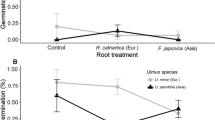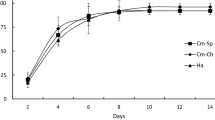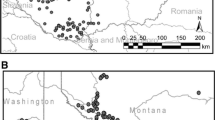Abstract
Recent studies suggest that the invasive success of Centaurea maculosa may be related to its stronger allelopathic effects on native North American species than on related European species, one component of the “novel weapons” hypothesis. Other research indicates that C. maculosa plants from the invasive range in North America have evolved to be larger and better competitors than conspecifics from the native range in Europe, a component of the “evolution of increased competitive ability” hypothesis. These hypotheses are not mutually exclusive, but this evidence sets the stage for comparing the relative importance of evolved competitive ability to inherent competitive traits. In a competition experiment with a large number of C. maculosa populations, we found no difference in the competitive effects of C. maculosa plants from North America and Europe on other species. However, both North American and European C. maculosa were much better competitors against plants native to North America than congeners native to Romania, collected in areas where C. maculosa is also native. These results are consistent with the novel weapons hypothesis. But, in a second experiment using just one population from North America and Europe, and where North American and European species were collected from a broader range of sites, competitive interactions were weaker overall, and the competitive effects of C. maculosa were slightly stronger against European species than against North American species. Also consistent with the novel weapons hypothesis, (±)-catechin had stronger effects on native North American species than on native European species in two experiments. Our results suggest that the regional composition of the plant communities being invaded by C. maculosa may be more important for invasive success than the evolution of increased size and competitive ability.







Similar content being viewed by others
References
Bais HP, Walker TS, Stermitz FR, Hufbauer RA, Vivanco JM (2002) Enantiomeric-dependent phytotoxic and antimicrobial activity of (±)-catechin. A rhizosecreted racemic mixture from spotted knapweed. Plant Physiol 128:1173–1179
Bais HP, Vepachedu R, Gilroy S, Callaway RM, Vivanco JM (2003) Allelopathy and exotic plant invasion: from molecules and genes to species interactions. Science 301:1377–1380
Blair AC, Hanson BD, Brunk GR, Marrs RA, Westra P, Nissen SJ, Hufbauer RA (2005) New techniques and findings in the study of a candidate allelochemical implicated in invasion success. Ecol Lett 8:1039–1047
Blair AC, Nissen SJ, Brunk GR, Hufbauer RA (2006) A lack of evidence for an ecological role of the putative allelochemical (±)-catechin in spotted knapweed invasion success. J Chem Ecol 32:2327–2331
Blossey B, Nötzold R (1995) Evolution of increased competitive ability in invasive nonindigenous plants: a hypothesis. J Ecol 83:887–889
Bossdorf O, Prati D, Auge H, Schmid B (2004) Reduced competitive ability in an invasive plant. Ecol Lett 7:346–353
Bossdorf O, Auge H, Lafuma L, Rogers WE, Siemann W, Prati D (2005) Phenotypic and genetic differentiation between native and introduced plant populations. Oecologia 144:1–11
Callaway RM, Aschehoug ET (2000) Invasive plants versus their new and old neighbors: a mechanism for exotic invasion. Science 290:521–523
Callaway RM, Maron JL (2006) What have exotic plant invasions taught us over the past 20 years? Trends Ecol Evol 21:369–374
Callaway RM, Ridenour WM (2004) Novel weapons: a biochemically based hypothesis for invasive success and the evolution of increased competitive ability. Front Ecol Environ 2:436–443
Callaway RM, Thelen GC, Rodriguez A, Holben WE (2004) Soil biota and exotic plant invasion. Nature 427:731–733
Callaway RM, Ridenour WM, Laboski T, Weir T, Vivanco JM (2005) Natural selection for resistance to the allelopathic effects of invasive plants. J Ecol 93:576–583
Callaway RM, Cipollini D, Barto K, Thelen GC, Hallett SG, Prati D, Stinson K, Klironomos J (2008) Novel weapons: invasive plant suppresses fungal mutualists in America but not in its native Europe. Ecology 89:1043–1055
Cappuccino N, Arnason JT (2006) Novel chemistry of invasive exotic plants. Biol Lett 2:189–193
Cappuccino N, Carpenter D (2005) Invasive exotic plants suffer less herbivory than non-invasive plants. Biol Lett 1:435–438
Carpenter D, Cappuccino N (2005) Herbivory, time since introduction and the invasiveness of exotic plants. J Ecol 93:315–321
D’Abrosca B, Dellagreca M, Fiorention A, Isidori M, Monaco P, Pacifico S (2006) Chemical constituents of the aquatic plant Schoenoplectus lacustris: evaluation of phytotoxic effects on the green alga Selenatrum capricornutum. J Chem Ecol 32:81–96
Ellstrand NC, Schierenbeck KA (2000) Hybridization as a stimulus for the evolution of invasiveness in plants. Proc Natl Acad Sci USA 97:7043–7050
Furubayashi A, Hiradate S, Fujii Y (2007) Role of catechol structure in the adsorption and transformation reactions of l-DOPA in soils. J Chem Ecol 33:239–250
Genton BJ, Kotanen PM, Cheptou P-O, Adolphe C, Shykoff JA (2005) Enemy release but no evolutionary loss of defence in a plant invasion: an inter-continental reciprocal transplant experiment. Oecologia 146:404–414
Goldberg DE (1987) Neighborhood competition in an old-field plant community. Ecology 68:1211–1223
Hierro JL, Maron JL, Callaway RM (2005) A biogeographic approach to plant invasions: the importance of studying exotics in their introduced and native range. J Ecol 93:5–15
Inderjit, Pollock JL, Callaway RM, Holben W (2008a) Phytotoxic effects of (±)-catechin in vitro, in soil, and in the field. PLoS ONE 3(7):e2536. doi:10.1371/journal.pone.0002536
Inderjit, Seastedt TR, Callaway RM, Pollock JL, Kaur J (2008b) Allelopathy and plant invasions: traditional, congeneric, and biogeographical approaches. Biol Invasions 10:875–890. doi:10.1007/s10530-008-9239-9
Iqbal Z, Hiradate S, Noda A, Isojima SI, Fujii Y (2003) Allelopathic activity of buckwheat: isolation and characterization of phenolics. Weed Sci 51:657–662
Jakobs G, Weber E, Edwards PJ (2004) Introduced plants of the invasive Solidago gigantean (Asteraceae) are larger and grow denser than conspecifics in the native range. Divers Distrib 10:11–19
Janzen DH (1975) Pseudomyrmex nigripilosa: a parasite of a mutualism. Science 188:936–937
Joshi J, Vrieling K (2005) The enemy release and EICA hypothesis revisited: incorporating the fundamental difference between specialist and generalist herbivores. Ecol Lett 8:704–714
Keane RM, Crawley MJ (2002) Exotic plant invasions and the enemy release hypothesis. Trends Ecol Evol 17:164–170
Leger EA, Rice KJ (2003) Invasive Californian poppies (Eschscholzia californica Cham.) grow larger than native individuals under reduced competition. Ecol Lett 6:257–264
LeJeune KD, Seastedt TR (2001) Centaurea species: the forb that won the west. Conserv Biol 15:1568–1574
Mallik AU, Pellissier F (2000) Effects of Vaccinium myrtillus on spruce regeneration: testing the notion of coevolutionary significance of allelopathy. J Chem Ecol 26:2197–2209
Maron JL, Vilà M, Arnason J (2004a) Loss of enemy resistance among introduced populations of St. John’s Wort, Hypericum perforatum. Ecology 85:3243–3253
Maron JL, Vilà M, Bommarco R, Elmendorf S, Beardsley P (2004b) Rapid evolution of an invasive plant. Ecol Monogr 74:261–280
McKenney JL, Cripps MG, Price WJ, Hinz HL, Schwarzländer M (2007) No difference in competitive ability between invasive North American and native European Lepidium draba populations. Plant Ecol 193:293–303
Müller H (1989) Growth pattern of diploid and tetraploid spotted knapweed, Centaurea maculosa Lam. (Compositae), and effects of the root-mining moth Agapeta. Weed Res 29:103–111
Müller-Schärer H, Schroeder D (1993) The biological control of Centaurea spp. in North America: do insects solve the problem? Pestic Sci 37:343–353
Müller-Schärer H, Schaffner U, Steinger T (2004) Evolution in invasive plants: implications for biological control. Trends Ecol Evol 19:417–422
Perry LG, Johnson C, Alford ER, Vivanco JM, Paschke MW (2005a) Screening of grassland plants for restoration after spotted knapweed invasion. Restor Ecol 13:725–735
Perry LG, Thelen GC, Ridenour WM, Weir TL, Callaway RM, Paschke MW, Vivanco JM (2005b) Dual role for an allelochemical: (±)-catechin from Centaurea maculosa root exudates regulates conspecific seedling establishment. J Ecol 93:1126–1135
Perry LG, Thelen GC, Ridenour WM, Callaway RM, Paschke MW, Vivanco JM (2007) Soil concentrations of the allelochemical (±)-catechin. J Chem Ecol 2171–2345
Prati D, Bossdorf O (2004) Allelopathic inhibition of germination by Alliaria petiolata (Brassicaceae). Am J Bot 91:285–288
Rabotnov TA (1982) Importance of the evolutionary approach to the study of allelopathy. Ékologia 3:5–8 (translated from Russian)
Ridenour WM, Callaway RM (2001) The relative importance of allelopathy in interference: the effects of an invader on a native bunchgrass. Oecologia 126:444–450
Ridenour WM, Vivanco JM, Feng Y, Horiuchi J, Callaway RM (2008) No evidence for tradeoffs: Centaurea plants from America are better competitors and defenders than plants from the native range. Ecol Monogr 78:369–386
Roché BF, Roché CT (1988) Distribution and amount of four knapweed (Centaurea L.) species in eastern Washington. Northwest Sci 62:242–253
Rudrappa T, Bonsall J, Gallagher JL, Seliskar DM, Bais HP (2007) Root-secreted allelochemical in the noxious weed Phragmites australis deploys a reactive oxygen species response and microtubule assembly disruption to execute rhizotoxicity. J Chem Ecol 33:1898–1918
Sheley RL, Jacob JS, Carpinelli MF (1998) Distribution, biology, and management of diffuse knapweed (Centaurea diffusa) and spotted knapweed (Centaurea maculosa). Weed Technol 12:353–362
Siemann E, Rogers WE (2001) Genetic differences in growth of an invasive tree species. Ecol Lett 4:514–518
Siemann E, Rogers WE (2003a) Increased competitive ability of an invasive tree may be limited by an invasive beetle. Ecol Appl 13:1503–1507
Siemann E, Rogers WE (2003b) Reduced resistance of invasive varieties of the alien tree Sapium sebiferum to a generalist herbivore. Oecologia 135:451–457
Simões K, Du J, Kretzshmar FS, Broeckling CD, Stermiz FS, Vivanco JM, Braga MR (2008) Phytotoxic catechin exuded by seeds of the tropical weed Sesbania virgata. J Chem Ecol 34:681–687
Strauss S, Webb CO, Salamin N (2006) Exotic taxa less related to native species are more invasive. Proc Natl Acad Sci USA 103:5841–5845
Thelen GC, Vivanco JM, Newingham B, Good W, Bais HP, Landres P, Caesar A, Callaway RM (2005) Insect herbivory stimulates allelopathic exudation by an invasive plant and suppression of natives. Ecol Lett 8:209–217
Thorpe AS (2006) Biochemical effects of Centaurea maculosa on soil nutrient cycles and plant communities. Ph.D. dissertation, The University of Montana, Missoula, MT
Vivanco JM, Bais HP, Stermitz F, Thelen GC, Callaway RM (2004) Biogeographical variation in community response to root allelochemistry: novel weapons and exotic invasion. Ecol Lett 7:285–292
Weir TL, Bais HP, Vivanco JM (2003) Intraspecific and interspecific interactions mediated by a phytotoxin, (±)-catechin, secreted by the roots of Centaurea maculosa (spotted knapweed). J Chem Ecol 29:2379–2393
Weir TL, Bais HP, Stull VJ, Callaway RM, Thelen GC, Ridenour WM, Bhamidi S, Stermitz FR, Vivanco JM (2006) Oxalate contributes to the resistance of Gaillardia grandiflora and Lupinus sericeus to a phytotoxin produced by Centaurea maculosa. Planta 223:785–795
Wolfe LM (2002) Why alien invaders succeed: support for the escape-from-enemy hypothesis. Am Nat 160:705–711
Acknowledgments
The authors are grateful to Courtney Hall, Alfonso Valiente-Banuet, and Daniel Montesinos for their help during the course of experiments. This study was supported by grants awarded to Wei-Ming He (2003CB415103, 30770335) and Ragan M. Callaway (Aldo Leopold Wilderness Center, the USFS Fire Sciences Laboratory, the USDA, DoD SERDP, the National Science Foundation, the Civilian Research and Development Foundation, and the Office of Sponsored Research at The University of Montana). This research was carried out in compliance with the laws of the United States of America.
Author information
Authors and Affiliations
Corresponding author
Electronic supplementary material
Rights and permissions
About this article
Cite this article
He, WM., Feng, Y., Ridenour, W.M. et al. Novel weapons and invasion: biogeographic differences in the competitive effects of Centaurea maculosa and its root exudate (±)-catechin. Oecologia 159, 803–815 (2009). https://doi.org/10.1007/s00442-008-1234-4
Received:
Accepted:
Published:
Issue Date:
DOI: https://doi.org/10.1007/s00442-008-1234-4




